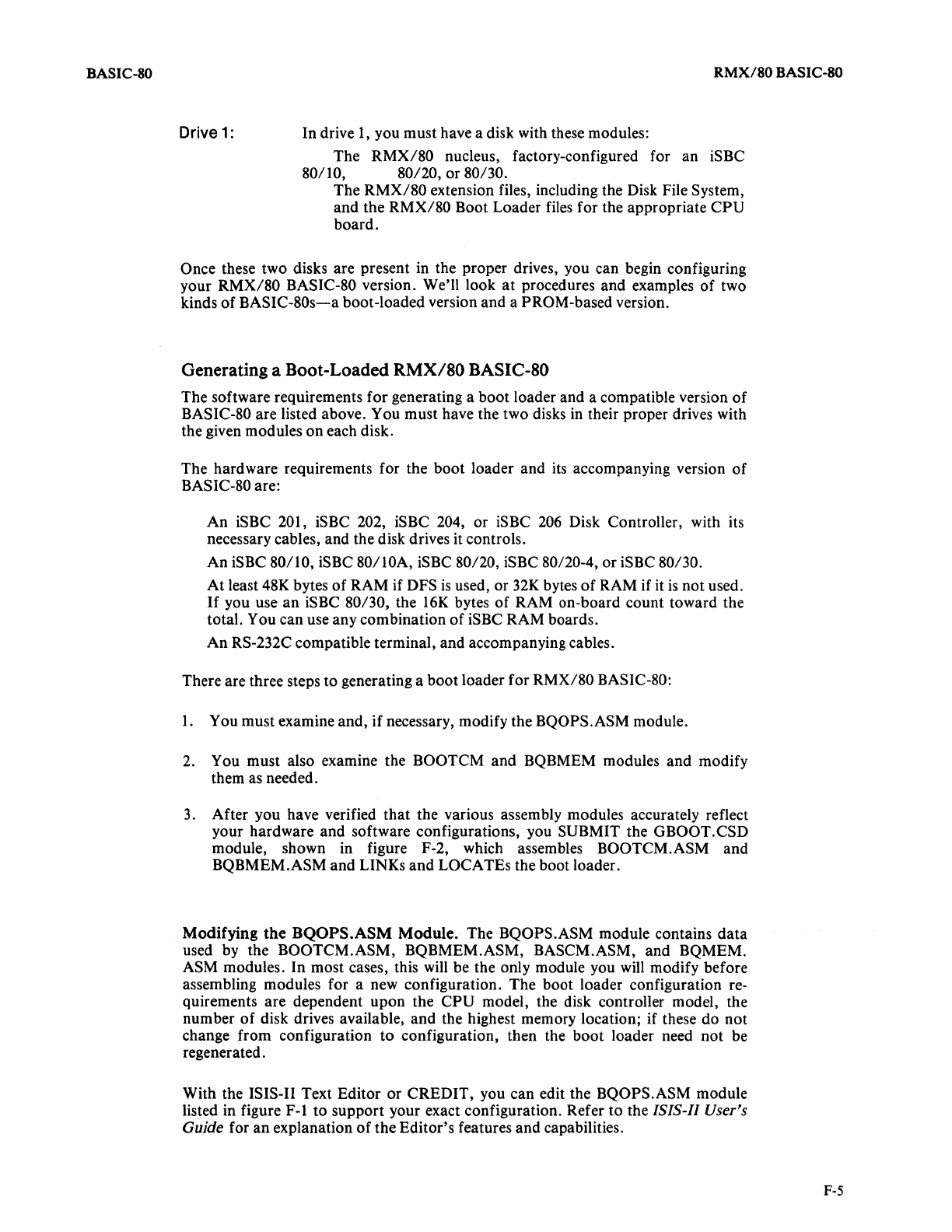
BASIC-80
RMX/80
BASIC-80
Drive 1: In drive I, you must have a disk with these modules:
The
RMX/SO nucleus, factory-configured for an iSBC
SO/IO,
SO/20,orSO/30.
The RMX/SO extension files, including the Disk File System,
and the RMX/SO Boot Loader files for the appropriate
CPU
board.
Once these two disks are present in the proper drives, you can begin configuring
your
RMX/SO BASIC-SO version. We'll look
at
procedures and examples
of
two
kinds
of
BASIC-SOs-a
boot-loaded version and a PROM-based version.
Generating a Boot-Loaded
RMX/80
BASIC-80
The software requirements
for
generating a boot loader and a compatible version
of
BASIC-SO are listed above. You must have the two disks in their proper drives with
the given modules
on
each disk.
The hardware requirements for the
boot
loader and its accompanying version
of
BASIC-SO are:
An
iSBC 201, iSBC 202, iSBC 204, or iSBC
206
Disk Controller, with its
necessary cables, and the disk drives it controls.
An
iSBC SO/IO, iSBC SO/IOA, iSBC SO/20, iSBC
SO/20-4,
or
iSBC SO/30.
At
least
4SK
bytes
of
RAM if DFS
is
used, or
32K
bytes
of
RAM if
it
is
not
used.
If
you use
an
iSBC SO/30, the
16K
bytes
of
RAM on-board count toward the
total.
You can use any combination
of
iSBC RAM boards.
An
RS-232C compatible terminal, and accompanying cables.
There are three steps to generating a
boot
loader
for
RMX/SO BASIC-SO:
1.
You must examine and,
if
necessary, modify the BQOPS.ASM module.
2.
You must also examine the BOOTCM
and
BQBMEM modules and modify
them as needed.
3.
After you have verified that the various assembly modules accurately reflect
your hardware and software configurations, you
SUBMIT the GBOOT.CSD
module, shown in figure F-2, which assembles BOOTCM.ASM and
BQBMEM.ASM
and
LINKs
and
LOCATEs the boot loader.
Modifying
the
BQOPS.ASM
Module.
The BQOPS.ASM module contains
data
used by the BOOTCM.ASM, BQBMEM.ASM, BASCM.ASM, and BQMEM.
ASM modules. In most cases, this will be the only module you will modify before
assembling modules for a new configuration. The boot loader configuration re-
quirements are dependent upon the
CPU
model, the disk controller model, the
number
of
disk drives available, and the highest memory location; if these do not
change from configuration
to
configuration, then the
boot
loader need not be
regenerated.
With the
ISIS-II Text Editor
or
CREDIT, you can edit the BQOPS.ASM module
listed in figure F-I
to
support your exact configuration. Refer
to
the ISIS-II User's
Guide for
an
explanation
of
the
Editor's
features and capabilities.
F-5


















